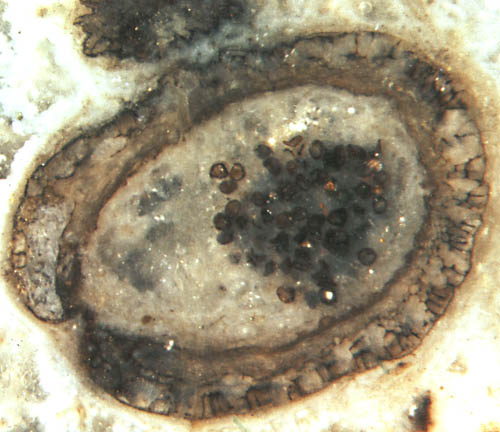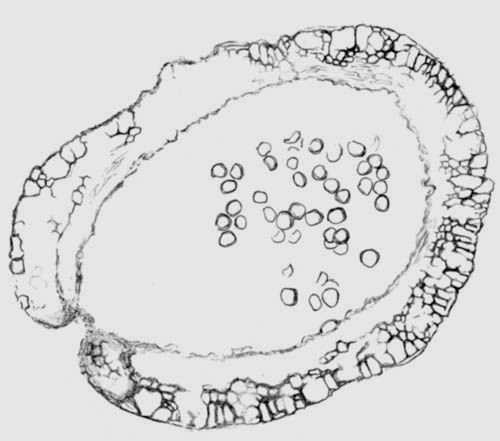Nothia
sporangium close-up
After it
had been shown by A.G. Lyon
in 1964 that small sporangia in the Rhynie chert often seen together
with
Asteroxylon do
not belong to the latter but to another plant which he named
Nothia
[1],
this plant was thoroughly
investigated by means of peel sections,
with the results published in 1979 [2]. The sections of sporangia shown
there (Figs.4,5 in [2]) do not show as much detail as the present
ones, possibly because of the small size in print. Therefore, a
larger picture of a
Nothia sporangium
with more detail is presented here.


Image: Nothia
sporangium
in Rhynie chert. Note the cross-sections of big tube-like voids in the
capsule wall as components of a complex structure involving various
cell
types. The
gap in the sporangium wall is the dehiscence slit seen in
cross-section.
Width of the picture 1.9mm.
It
must have taken a series of evolutionary steps to bring forth a wall
structure as complex as this one. As a most peculiar feature, a few
tube-like "giant cells" are embedded in the epidermis in such a way
that only a narrow strip of every one appears on the surface while
the bulk is hidden beneath [3]. They are seen here in cross-section.
They had tentatively been regarded as cavities analogous to stoma
chambers [2] but alternatively interpreted as big tube-like cells with
up to 1.6mm length in the most detailed publication on Nothia
[3]: "The most characteristic feature of the epidermis of Nothia aphylla is
the presence of the enigmatic giant cells."
The present sample provides a surprise: Some of the "giant
cells" do not look as empty as they are supposed to be. Cell walls
extending from the edges of neighbouring cells are faintly seen inside.
Hence, the alleged giant cells seem to have formed from bundles of
narrower cells with thin and frail walls between them which disappeared
at some stage of maturation. If this happened while or after the plasma
itself broke down, the
resulting larger compartment could not be called
a cell. Then what is called giant cells would simply be closed
cavities, differing from the type of cavity envisaged in [2]. They
could have served as water storage vessels [3] or as hollow
structural elements, possibly filled with
air. However, the fact that they are found mainly on the aerial axes
and on the sporangia suggests a more
sophisticated interpretation: They may have served as tubes
filled with poisonous or irritating liquid, a deterrent also applied by
a
large variety of extant
plants.
Some of the milk-producing
plants make their tubes by removing the walls between adjacent cells.
Possibly Nothia
was able to do the same. The advantage of tubes for
such purpose is obvious: If tapped by a spore eater, a tube under
pressure would spill its content profusely and soil the biting creature
with sticky liquid with possibly fatal effect.
H.-J. Weiss
2009
[1] A.G. Lyon:
Nature 203 (1964), 1082-83.
[2] W.El-S.
El-Saadawy, W.S. Lacey:
Observations on Nothia
aphylla,
Rev.
Palaeobot. Palyn. 27 (1979),
119-147.
[3] H. Kerp, H.
Hass, V. Mosbrugger: New data
on Nothia aphylla,
in: P.G. Gensel,
D. Edwards (eds.): Plants Invade the Land, N.Y. 2001.
 |
 |
33 |





